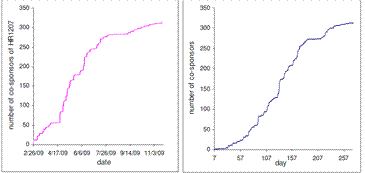To Understand Congress, Just Watch the Sandpile
What does it take for a resolution in Congress to achieve sizeable support? It’s easy to imagine that the support of certain influential representatives is crucial because of their skill in the cut and thrust of political bargaining.

Not so, say Mikhail Simkin and Vwani Roychowdhury at the University of California, Los Angeles. It turns out that the way a particular resolution gains support can be accurately simulated by the avalanches that occur when grains of sand are dropped onto each other to form a pile.
Simkin and Roychowdhury begin their analysis with a study of resolution HR1207 and a plot of the number of co-sponsors it received against time early last year. This plot is known in mathematics as a Devil’s staircase–it consists of long periods without the addition of any new co-sponsors followed by jumps when many new co-sponsors join during a single day. “One might have suspected that the biggest steps of the staircase are due to joining of a highly influential congressman bringing with himself many new co-sponsors which he had influenced,” say Simkin and Roychowdhury.
That’s uncannily similar to the way in which avalanches proceed in a a model of sandpiles developed by Per Bak, Chao Tang and Kurt Wiesenfeld in 1988. Perhaps Congress can be modelled in a similar way, reason Simkin and Roychowdhury.
Their model assumes that the roles of sand grains is played units of political pressure. They assume that there is a network of influence in Congress through which representatives exert political pressure on each other (just as sand grains exert forces on each other through the network of contacts between them in the pile). When the pressure on representatives reaches a threshold, they co-sponsor the resolution and this, in turn, puts pressure on other member of congress to sign.
This is like the pressure that builds up in a sandpile as grains are dropped onto it. When a threshold is reached at a certain point on the pile, an avalanche occurs which redistributes the pressure to other places.
In addition, the representatives are pressured by their constituents which is analogous to dropping grains of sand at random.
There is a difference between sandpiles and congress however. Once a representative has signed, he or she cannot do it again and so take no further part in the process. Any further pressure on them is simply dissipated. So representatives cannot topple more than once, unlike sand grains which can keep on toppling as the pile gets bigger.
This is a pretty simple model but when Simkin and Roychowdhury ran it, they found that it generates a Devil’s staircase that is uncannily similar to the one generated by representatives for HR1207.
Perhaps the most interesting feature is that the model assumes that all representatives have equal influence. “In our model, big steps are a result of evolution of Congress to a sort of critical state, where any congressman can trigger an avalanche of co-sponsors,” say Simkin and Roychowdhury.
The pair suggest some interesting ways to follow up their work. They point out that not all resolutions in Congress get the same level of support. In their model, this is due to the amount of public pressure, ie the number of units of political pressure dropped onto the pile at random. If there is no outside pressure, the resolution will not get sizeable support in a reasonable amount of time.
“An obvious extension to the model is to introduce political pressure against the resolution,” they say, pointing out that an interesting case would be when the negative pressure exactly balances the positive. “It could explain the cases when a resolution quickly gains some support, which, however, never becomes overwhelming.”
So representatives are not as important as perhaps they might imagine. Perhaps the stage should be replacing them with actual grains of sand. By Simkin and Roychowdhury’s reckoning, it wouldn’t make much difference.
Ref: arxiv.org/abs/1001.3732: Stochastic modeling of Congress
Keep Reading
Most Popular
Large language models can do jaw-dropping things. But nobody knows exactly why.
And that's a problem. Figuring it out is one of the biggest scientific puzzles of our time and a crucial step towards controlling more powerful future models.
The problem with plug-in hybrids? Their drivers.
Plug-in hybrids are often sold as a transition to EVs, but new data from Europe shows we’re still underestimating the emissions they produce.
Google DeepMind’s new generative model makes Super Mario–like games from scratch
Genie learns how to control games by watching hours and hours of video. It could help train next-gen robots too.
How scientists traced a mysterious covid case back to six toilets
When wastewater surveillance turns into a hunt for a single infected individual, the ethics get tricky.
Stay connected
Get the latest updates from
MIT Technology Review
Discover special offers, top stories, upcoming events, and more.